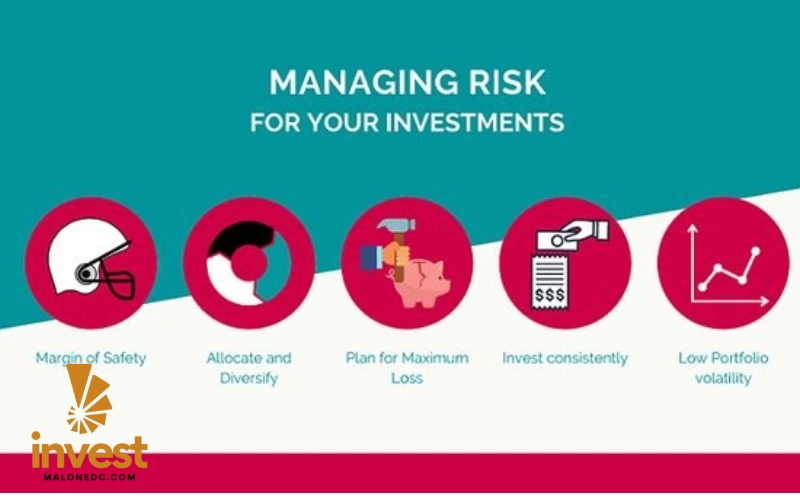Risk management in investment is one of the important factors that help investors protect assets and optimize profits. In the financial market, not paying attention to risks can lead to great losses. Every investment decision carries a certain level of risk, and the important thing is how to control and minimize those risks effectively. In this article, we will explore risk management methods in investment, thereby helping investors build a solid and sustainable investment strategy.
1. UNDERSTAND THE TYPES OF RISKS IN INVESTMENT
Before applying risk management measures, investors need to clearly understand the types of risks that may be encountered in investment. Risks can come from many factors, including the market, interest rates, or changes in the macroeconomic environment. The main types of risks that investors need to be aware of include:

Market risk: Is the fluctuation of asset values in the market. The value of investments can decrease due to changes in the market, such as changes in supply and demand or impacts from external factors such as financial and political crises.
Interest rate risk: When interest rates change, the value of assets such as bonds or stocks can be affected. High interest rates can often reduce the value of capital assets and affect the profitability of investments.
Credit risk: Is the possibility that a counterparty or bond issuer cannot repay a loan or repay a debt. This affects investors who own assets with low credit ratings.
Liquidity risk: Is the ability to buy or sell an asset without affecting its value. If an asset is difficult to trade or has an illiquid market, investors may have difficulty selling the asset.
2. DIVERSIFY YOUR INVESTMENT PORTFOLIO
One of the most effective ways to manage investment risk is to diversify your investment portfolio. Diversification helps reduce the impact of a particular asset on the entire portfolio. If one asset falls in value, other assets may maintain their value or even increase in value, helping to protect investors from losses.
Specifically, diversification can be done in many forms, such as allocating money to different types of assets (stocks, bonds, gold, real estate, etc.), or allocating to different industries and geographic regions. Each type of asset will have different levels of risk and return, so building a diversified portfolio will help investors reduce overall risk and achieve more stable returns.
3. RATIONAL ASSET ALLOCATION
Asset allocation is an important part of risk management strategy. Proper allocation between assets will help you minimize the possibility of loss in bad situations. A common principle in asset allocation is “80/20”, which means 80% of assets in high-risk investments such as stocks and 20% in safe assets such as bonds or gold.
However, this allocation ratio can vary depending on each investor’s goals and risk tolerance. If you have a long-term investment time horizon and a high risk tolerance, you can allocate more to growth assets. If you are close to retirement age or need to use money in the near future, it is reasonable to allocate more to less risky assets.
4. USING STOP LOSS ORDERS
A stop loss order is a useful tool for investors to limit losses when the market moves against their predictions. When the price of an asset falls to a certain level, a stop loss order will automatically sell that asset, preventing further losses. This is a useful method for investors to protect their existing profits and avoid large losses in unfavorable market situations.
Stop loss orders can be set at a fixed price or as a percentage of the asset’s value. However, investors need to be careful in setting the stop loss appropriately, because if they set it too close to the current value, you may be sold out when there are small fluctuations in the market.
5. MONITOR AND ADJUST YOUR PORTFOLIO
Risk management is not just about developing strategies and tools at the beginning, but also about monitoring and adjusting your portfolio over time. Financial markets are always changing, so regularly monitoring and adjusting your portfolio will help you optimize your returns and minimize your risks.
When factors such as economic, political or interest rate situations change, you need to review your asset allocation and possibly adjust your portfolio to suit the new circumstances. Rebalancing your portfolio periodically helps ensure that you maintain a reasonable level of risk and are not too concentrated in any one asset class.
6. MANAGE EMOTIONS WHEN INVESTING
Managing emotions is an important part of risk management. Emotions such as greed, fear, or anxiety can cause investors to make bad decisions. For example, when the market is growing strongly, investors may become greedy and invest too much in an asset, leading to great risks when the market reverses. Conversely, when the market is falling, investors may sell off assets for fear of losing money.
To manage risks effectively, investors need to stay calm, patient and adhere to the strategies they have set. Remember that investing is a long-term process, and decisions should not be made based on temporary emotions.
CONCLUSION
Risk management is an important skill that helps investors protect assets and maintain stability in their investment strategy. Methods such as diversification, reasonable asset allocation, using stop-loss orders and monitoring, and periodic portfolio adjustments will help minimize risks and optimize profits. Moreover, managing emotions when investing is also an indispensable factor to avoid making wrong decisions. By applying effective risk management strategies, you will be able to build a solid and sustainable investment portfolio, achieving your financial goals in the long term.
